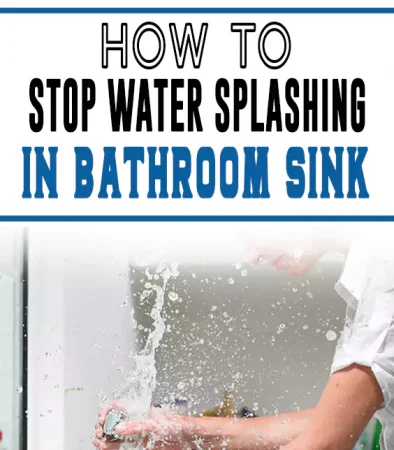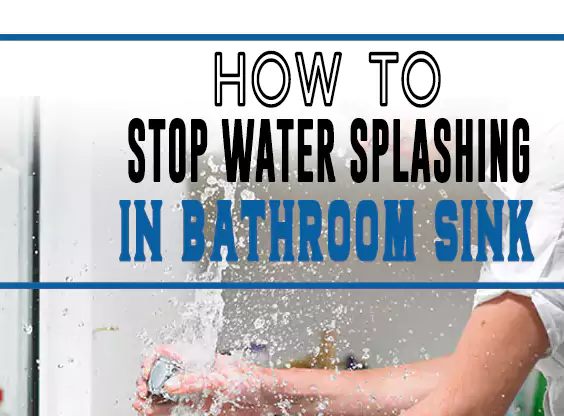Water splashing occurs in the bathroom sink because of the use of water. Here’s FIVE tips to stop water splashing in bathroom sink.
Excessive water splashing in the bathroom sink keeps your bathroom wet and might make you slip off.
However, the way the water comes pouring from the tap, the depth and size of the bathroom sink, faucet’s water pressure are some factors responsible for causing excessive water splashing in the bathroom.
To avoid an unhygienic bathroom and spending a high amount on water bills, you need to stop water splashing in the bathroom sink as soon as possible.
In this article, I’ll share 5 methods to stop water splashing in the bathroom sink, the reasons behind it, and ways to keep your bathroom sink hygienic.

6 Reasons for Water Splashing in the Bathroom Sink
No one likes the sight of water splashing around the bathroom sink. However, many people will be curious to find out what causes water splashing or its reasons.
Several factors cause water splashing in the bathroom sink. They are outlined as follows:
1. The High Flow Rate
The high velocity of water is one of the common causes of water splashing in bathroom sinks.
The estimated flow rate for an ideal bathroom sink is 1.5 GPM (Gallons per minute). When the flow rate exceeds this, it may cause splashing in the bathroom sink.
2. Incorrect Faucet
Bathroom sink faucets have a low water flow rate compared to the kitchen and bathtub faucets.
Therefore, when a wrong faucet is installed in a bathroom sink, water splashing is bound to happen. People also experience kitchen faucet splashing too much because of unfit faucets.
3. Wrong Positioning
Wrong positioning of the faucet is another factor affecting water splashing in bathroom sinks. Many faucets are incredibly high and are placed high above the rim of the sink.
Other times, it is positioned some distance away from the middle of the sink.
4. High Water Pressure
High-pressure water leads to splash because the tap will find it challenging to regulate the high pressure of the water. However, high pressure can be controlled by installing the right tools.
5. Size and Depth of Bathroom Sinks
Many undermount bathroom sinks are shallow and allow the water to travel a short distance. The resulting motion will cause water to splash around. Shallow bathroom sinks look appealing to the eyes but keep the bathroom a mess.
A large bowl will retain a high quantity of water and redirect the water flow from the bottom to the edge. To reduce the splashing problem in the bathroom, you can install a deep rectangular undermount bathroom sink.
6. The Presence of an Aerator
Aerators are devices installed on the tip of the faucet. It allows air to combine with water as it leaves the spout. Its principal function is to slow down the pressure of the water and thereby reduce the possibility of water splashing.
How to Stop Water Splashing in Bathroom Sink
Required tools and material:
- An aerator
- A measuring tape
- A bathroom sink faucet
- A pressure reduction value
- Sink grid
- Sink protection
Method 1: Using Aerator
An aerator is less expensive and an excellent option to stop water splashing. The primary function of the aerator is to reduce the pressure of water leaving your faucet. To use it, you need to attach it to the end of your faucet.
Method 2: Control High Water Pressure
The high pressure of water is also responsible for water splashing. Therefore, controlling the high pressure of water will help prevent splashing. Here are some ways to control high pressure:
1. Open the tap partly
Opening your tap partly is an easy, cheap, and effective way to reduce water pressure.
When using the tap, turn the faucet partially (halfway or three-quarter way) to get a low flow rate to prevent water splashing.
However, a single-handle faucet may be difficult, but a double-handle faucet won’t give you any trouble.
2. Install a pressure-reducing valve
A pressure reducing valve is usually connected to the water meter on your property. It works by regulating the whole pressure of water in your home.
3. Regulate the shut-off valve
The shut-off valve will help reduce the volume of water going to your bathroom sink. Adjusting it halfway or three-quarter way closed will prevent water behind the bathroom sink and overall water splashing!
Method 3: Using a Right Faucet
The size and depth of your bathroom sink will affect the release of water. A narrow or depthless sink will undoubtedly lead to water splashing.
However, a faucet with a short spout will reduce splashing water from the bathroom sink. It works by keeping the water in a straight path to the drain to stop splashing.
Method 4: Using a Sink Grid and Sink Protection
Using a sink grid and sink protector mat are perhaps among the easy ways to stop water splashing in the sink.
A sink grid comes in various sizes, and you need to measure the length and inside width of the bathroom sink to buy the appropriate size. The grid helps stop water splashing by separating water as it lands on it.
A sink mat is a soft cloth that you can cover over the rims of your bathroom sink. It helps stop splashing by absorbing water rather than allowing it to spill on the floor.
You can also purchase a cloth that fits your faucet and handles to avoid the splash in the bathroom sink.
How to Keep the Bathroom Sink Hygienic?
A dirty bathroom sink is unhealthy and unattractive to the eyes. Hence, the need to keep the bathroom sink hygienic is paramount and essential for healthy living.
Unfortunately, many people clean their bathrooms but do so wrongly. Here are some tips to keep your bathroom sink hygienic:
Brush your teeth with face level to the ground
To keep your bathroom sink hygienic, you need to adjust the way you position yourself while brushing. For example, when brushing your teeth, ensure that you keep your face level with the ground.
Facing up while brushing your teeth can send specks of toothpaste around your bathroom, especially if you brush your teeth twice daily. Over time, these specks turn to dirt and keep your bathroom messy.
Keep cleaning wipes nearby
Having cleaning wipes nearby will enable you easily clean up messes like toothpaste specks and watermarks rather than leaving them to stain or dry.
In addition, regular cleanup help fix messy sink splatter and keep your bathroom sink hygienic.
Use high-quality bathroom cleaners
Go for high-quality cleaners whenever you plan to clean your bathroom sink or other parts of your bathroom.
The effect of high-quality cleaners will last for an extended period compared to low-quality cleaners. Search and use formulas with long-lasting resistance to germs and bacteria.
Use a liquid soap with a pump
Choosing a liquid soap over a soap bar can help keep your bathroom sink counter dry and clean. You can also get a hands-free soap dispenser.
These options enable you to ditch your soap dish, which will give your bathroom sink a clean and attractive look.
Store dryer sheets nearby
Storing dryer sheets nearby will make it easily reachable. You can easily use it to pick hair and dust particles from around your bathroom sink.
With dryer sheets, you don’t need a vacuum cleaner. Daily usage of dryer sheets will keep your bathroom sink clean.
Store your tools properly
Design a spot or cabinet to store your toiletries, cosmetics, hair tools. A well-arranged cabinet and counter are pleasing to the eyes.
There’s nothing like a clutter-free bathroom. It keeps all your belongings in the right place and keeps your bathroom sink hygienic.
Wrap Up
Water splashing in the bathroom sink requires urgent intervention to mitigate its effects. The causes or reasons behind water splashing are numerous but can be tackled.
To avoid faucets spraying water everywhere, you need to get the right faucet for the bathroom sink and place it properly.
Before applying any of the methods, ensure that you get the required and correct materials and tools. There is no denying that prevention is better than cure. I hope now you’ll be able to stop water splashing in the bathroom while using a sink.

